When exploring for potentially habitable planets outside of our own solar system, it is the diminutive and frigid stars that hold the most potential. Known as M-class red dwarfs, these stars are significantly smaller and cooler than our Sun, yet they outnumber Sun-like stars by more than 10 times.
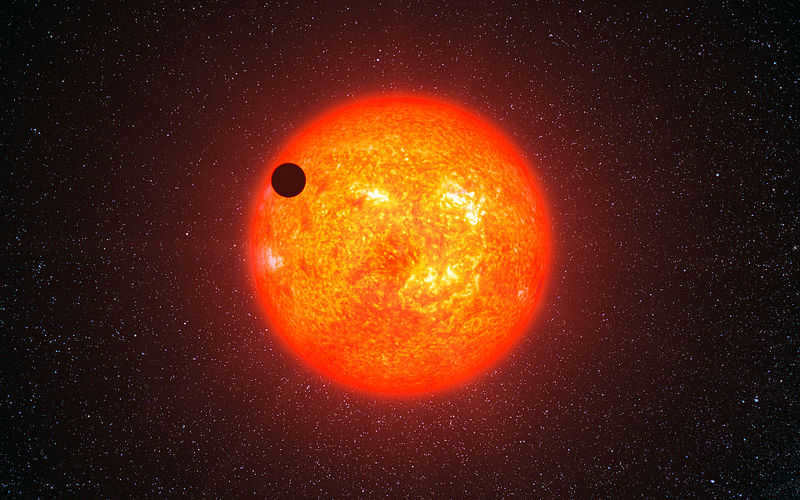
Exoplanet GJ 1214b, situated in a red dwarf system, as seen through the lens of an artist. (Credit: ESO/L. Calçada)
In order for planets to have enough warmth to form in red dwarf systems, they must be in close proximity to the star, much like campers huddling close to a campfire. This characteristic makes them relatively easy for planet hunters to locate, and the abundance of red dwarfs means that there are numerous such planets available for examination in our immediate vicinity.
Astronomers are currently diligently preparing for these studies. Several independent projects are already observing nearby red dwarfs, and numerous new telescopes and satellites are being developed to detect the planets that orbit them. One example is NASA’s TESS (Transiting Exoplanet Survey Satellite), which is scheduled to be launched in 2017.
These endeavors ensure that the identification of potentially inhabitable planets in red dwarf systems is on the horizon. Nevertheless, it remains uncertain whether all of these celestial bodies will ultimately be confirmed as habitable: the characteristics that enable the easy detection of red dwarf planets may also render them unsuitable for supporting life.
Oscillations and tides
Astronomers search for exoplanets by studying the oscillations of stars, which are periodic movements caused by the gravitational pull of unseen celestial bodies. If there is an Earth-sized planet located within the habitable zone of a red dwarf star, it will cause the star’s velocity to vary by 1 m/s, a change that can be easily detected from Earth. These variations in velocity occur every few weeks or months.
However, in certain cases, tidal forces can extract energy from the planet’s rotation, causing it to complete one full rotation on its axis during one revolution around its star. This means that one hemisphere of the planet would always be facing the star, much like how we always see the same side of the moon. In the most extreme scenario, all the water and air on such a planet would freeze and accumulate on the perpetually unlit side, rendering the planet’s surface uninhabitable.
Shades and glares
An alternative method of detecting planets is by observing shades created when they pass in front of their host star. Due to their smaller orbits, planets orbiting red dwarf stars block a greater amount of the star’s light compared to if they were orbiting larger stars, making them more easily detectable using this technique.
On the other hand, red dwarf stars are much dimmer than stars similar to the sun and exhibit more variability. They can dim significantly and experience flares and coronal holes on their surface, emitting X-rays and ultraviolet radiation that can impact planets. This unpredictability can have detrimental effects on the climate and biosphere. Consequently, a planet situated near such an erratic red dwarf star, which may otherwise support life, would be exposed to destructive outbursts that would obliterate its atmosphere.
A lengthy existence and a challenging early life
One factor contributing to the abundance of red dwarf stars is their exceptional longevity compared to other stars. Their population increases over time because, owing to their small size, they burn their nuclear fuel slowly and efficiently. However, this extended lifespan is only achieved after a tumultuous youth.
Contrary to expectations, red dwarfs take longer than larger stars to fully develop due to their diminutive size and weaker gravitational force. They can remain in a protostar state for hundreds of millions of years, gradually forming from collapsing gas clouds.
Interestingly, planets can form around these protostars in a matter of tens of millions of years. During the remaining duration, these celestial bodies would be subjected to intense heat and light emitted by the protostar, potentially causing the evaporation of significant amounts of life-sustaining water on their surfaces before the red dwarf fully forms.
A red dwarf is a type of star that is small and cold, with a mass ranging from 0.08 to 0.8 times that of the Sun. These stars are incredibly common and have long lifespans, making up around 75% of all known stars. Despite their abundance, red dwarfs are not visible to the naked eye due to their low brightness. In fact, out of the 30 closest stars to our Sun, 20 of them are red dwarfs.
One particularly noteworthy red dwarf is Proxima Centauri, which is located in the Centauri constellation and is only 4.2 light-years away from us. It was first discovered in 1915 by the Scottish astronomer Robert Innes (1861-1933).
However, even before Proxima Centauri was found, the French astronomer Joseph de Lalande (1732-1802) had already observed another red dwarf called Lalande 21185 in the Big Dipper constellation using his telescope.
The spectral classes are associated with the star’s surface temperature, causing its light to split into a set of distinct lines.
For instance, stars with spectral class K have temperatures ranging from 5000 to 3500 K and appear yellow-orange, while stars with spectral class M have temperatures below 3500 K and appear red.
Our Sun falls into spectral class G, appearing yellow and having a surface temperature between 5000 and 6000 K. Stars of a specific spectral class share numerous common characteristics, with mass being the most significant. The star’s mass also determines its evolution.
Distinctive Characteristics of Red Dwarfs
Red dwarfs possess specific unique features, some of which we have already mentioned earlier:
– They have a significantly low surface temperature.
– They have a low rate of material burning.
Dough
As stated previously, the primary factor determining a star’s classification is its mass. The abundance of red dwarfs can be attributed to the fact that there is a higher formation rate of low-mass stars compared to massive stars.
However, what is intriguing is that the formation time for low-mass stars is longer compared to that of very massive stars. The latter grow at a much faster pace due to the greater force of gravity compressing matter at the core, which is directly proportional to the mass.
Furthermore, it is widely known that a specific critical mass is necessary for the temperature to reach the optimal level for initiating fusion reactions. Consequently, the star commences its adult phase.
The formation of the Sun took millions of years, but a star that is five times larger can form in less than a million years, while the most massive stars can begin to shine in hundreds of thousands of years.
Temperature
Surface temperature, as mentioned, is another important characteristic that distinguishes red dwarfs. It must be below 5000K, but not below 2000K, otherwise it is too cool to be a true star.
Objects with temperatures below 2000K cannot have fusion reactions and are failed stars that never reached critical mass: brown dwarfs.
A more in-depth analysis of spectral lines can determine the difference between a red dwarf and a brown dwarf. For example, the presence of lithium suggests it is a red dwarf, but if it is methane or ammonia, it is likely a brown dwarf.
Spectral Types and the Hertzsprung-Russell Diagram
The Hertzsprung-Russell diagram, also known as the H-R diagram, is a graphical representation that illustrates the characteristics and evolution of stars based on their spectral properties. These properties include the surface temperature, which is the primary determining factor, as well as the luminosity of the star.
The H-R diagram consists of two axes: the vertical axis represents the luminosity, while the horizontal axis represents the effective temperature. This diagram was independently developed by astronomers Einar Hertzsprung and Henry Russell in the early 1900s.
Stars are classified into different spectral types based on the Harvard Spectral Classification system, which assigns a sequence of letters to indicate the temperature of the star:
We begin with the most popular O-type stars and the coolest M-type stars. On the graph, you can find the spectral types at the bottom, represented by the blue band on the left side and transitioning to red on the right side.
Each type has its own variations, as the intensity of the spectral lines differ. To further categorize each type, they are divided into 10 subcategories, labeled with numbers ranging from 0 to 9. The lower the number, the hotter the star. For instance, our Sun is classified as G2 while Proxima Centauri is an M6.
The central area of the graph, which runs diagonally, is known as the main sequence. The majority of stars fall within this category, although their evolution can cause them to move into other categories such as red giants or white dwarfs. This evolution is dependent on the star’s mass.
Red dwarf life typically occurs within the main sequence, and while most M-class dwarfs are red dwarfs, not all of them are. However, there are also supergiant stars within this classification, like Betelgeuse and Antares (located at the top right of the H-R diagram).
Stellar Evolution
The life cycle of a star commences with the gravitational collapse of interstellar matter. As the matter coalesces, it begins to spin faster and faster, eventually forming a disk due to the conservation of angular momentum. At the core of this disk lies a protostar, the embryonic form of a future star.
Over time, the temperature and density of the protostar increase until a critical mass is attained, triggering the ignition of the fusion reactor. This reactor will serve as the star’s energy source in the foreseeable future and necessitates a core temperature of approximately 8 million K.
Stabilization of the star’s core occurs through combustion, which counteracts the force of gravity and maintains hydrostatic equilibrium. This process is only possible within a mass range of 0.01 to 100 solar masses. If the mass exceeds this range, the protostar will overheat and undergo a catastrophic destruction.
After the fusion reactor is initiated and equilibrium is achieved, stars enter the main sequence on the H-R diagram. Red dwarfs have a slow energy emission rate, allowing their hydrogen supply to last for a significant amount of time. The energy radiated by a red dwarf is facilitated by the process of convection.
The conversion of hydrogen to helium in red dwarfs occurs through proton-proton chains, which involve the fusion of one hydrogen ion with another. The temperature of the star greatly influences this fusion process.
Once the hydrogen supply is depleted, the star’s reactor ceases to function and enters a phase of gradual cooling.
Proton-proton chain
The Proton-proton chain is a common reaction that occurs in stars that have recently joined the main sequence, as well as in red dwarfs. It begins as follows:
Where e + positron, which is identical to the electron except for its positive charge, and ν represents a neutrino, a mysterious and lightweight particle. Additionally, 2 1H represents deuterium or heavy hydrogen.
In the second case, the γ symbolizes the photon. Both reactions occur twice, resulting in:
How does a star generate energy through this process? Well, there is a slight difference in the mass of the reactions, resulting in a small mass loss that is then converted into energy according to Einstein’s famous equation:
Since this reaction occurs an infinite number of times involving a massive number of particles, the resulting energy is astronomical. However, this is not the sole reaction that takes place within a star, although it is most prevalent in red dwarfs.
The lifespan of a star
The lifespan of a star is also dependent on its mass. The following equation provides an estimation of that duration:
Where T represents time, and M represents mass. The usage of capital letters is appropriate due to the extensive length of time and the immense mass.
A star similar to the Sun exists for approximately 10 billion years, while a star 30 times the mass of the Sun has a lifespan of 30 million years, and a more massive star may endure for roughly 2 million years. In any case, that is an eternity for human beings.
Red dwarfs have an exceptionally long lifespan due to their efficient utilization of nuclear fuel. In terms of our perception of time, a red dwarf can be considered immortal because it takes longer to deplete the hydrogen in its core than the estimated age of the universe.
While red dwarfs have not yet reached the end of their lifecycle, our understanding of their longevity and ultimate fate is based on computer simulations using available information.
Based on these simulations, scientists hypothesize that when a red dwarf exhausts its hydrogen supply, it transitions into a blue dwarf.
Although no one has directly observed this type of star, as the hydrogen depletes, the red dwarf does not expand into a red giant star like our Sun will eventually. Instead, it increases in radioactivity and surface temperature, resulting in a blue hue.
The Components of Red Dwarfs
The composition of stars is quite comparable, as they are mostly massive spheres comprised of hydrogen and helium. They retain certain elements from the gas and dust that formed them, thus also containing traces of elements that contributed to the formation of previous stars.
Due to temperature, the composition of red dwarfs resembles that of the Sun, although the spectral lines differ significantly. Therefore, the presence of weak hydrogen lines in a star does not necessarily mean that it lacks hydrogen.
In astronomy, the definition of “metal” differs from its common understanding, as it refers to any element other than hydrogen and helium.
Research
The process of stellar formation is intricate and relies on various factors. There is still much to be discovered about this phenomenon, although it is thought to be universal for all stars, as explained in the preceding sections.
The quantity of matter a star is able to accumulate through gravity determines its size and color, which in turn is linked to its temperature.
An issue that perplexes astronomers and remains unresolved is the presence of heavier elements in red dwarfs, beyond hydrogen, helium, and lithium.
On one hand, according to the Big Bang theory, the initial stars that formed should consist solely of these three lightest elements. However, heavy elements have been detected in red dwarfs.
Furthermore, if no red dwarfs have yet perished, it implies that the first red dwarfs ever formed should still exist somewhere, composed entirely of light elements.
It is possible that red dwarfs could have formed at a later time, as they require the presence of heavy elements during their creation. Alternatively, it is also possible that there are first generation red dwarfs that have not yet been discovered, due to their small size and low luminosity.
Examples of red dwarfs
The next Centauri
Located 4.2 light-years away, the next Centauri has a mass equivalent to one-eighth of the Sun’s mass, but it is 40 times denser. This star, known as Proxima, possesses a strong magnetic field that makes it susceptible to flares.
Additionally, Proxima is known to have at least one planet called Proxima Centauri b, which was discovered in 2016. However, it is believed that this planet may have been swept away by the star’s frequent flares, making it unlikely to support life. This assumption is based on the fact that the star emits X-rays in its radiation.
Barnard’s Star
This red dwarf, located 5.9 light years away, is known for its remarkable velocity of approximately 90 km/s in the direction of the Sun.
Barnard’s Star is observable through telescopes and, similar to Proxima, it occasionally exhibits flares and outbursts. Recently, a planet orbiting this star has been detected.
Teegarden Star
This red dwarf, which has a mass equivalent to only 8% of that of the Sun, is situated in the Aries constellation and can only be observed through a high-powered telescope. It is considered one of the nearest stars, with a distance of approximately 12 light years.
Discovered in 2002, this star not only exhibits its own unique motion, but also appears to have planets located within the potentially habitable zone.
Wolf 359
Wolf 359 is a red dwarf star located in the constellation Leo, approximately 8 light years away from our solar system. Unlike other stars, Wolf 359 is variable in nature, meaning its luminosity increases periodically. However, these outbursts are not as intense as those observed in Proxima Centauri.
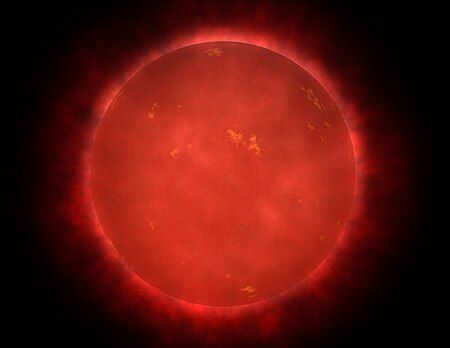
The Red Dwarf, as illustrated in the Hertzsprung-Russell diagram, is a compact and relatively low-temperature star found in the main sequence. It falls under the spectral class M or upper K.
Overview
By observing the phenomenon where red dwarfs stay on the main sequence while other stars transition away from it, we can ascertain the age of star clusters by identifying the point at which stars are compelled to leave the main sequence due to their mass. Furthermore, the absence of red dwarfs beyond the main sequence discovered thus far suggests that the universe possesses a limited duration.
Red dwarfs in the universe
Red dwarfs are the most abundant type of stars in the universe. Proxima Centauri, which is the nearest star to the Sun, is classified as a red dwarf (M5.5Ve spectral class; stellar magnitude 11.0 m). Additionally, twenty out of the thirty closest stars to us are also red dwarfs. Nevertheless, due to their low brightness, they have not been extensively researched.
The Issue with Primary Red Dwarfs
In order to maintain credibility, information must be able to be verified, otherwise it may be subject to scrutiny and removal.
To enhance the reliability of this article, you can contribute by including references from reputable sources.
This notation was placed on May 12, 2011.
Possibilities of Life on Planets Orbiting Red Dwarfs
Exoplanets
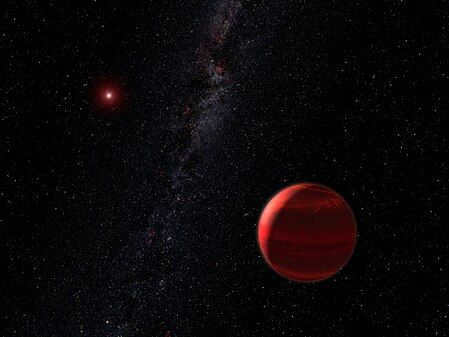
In 2005, scientists made a groundbreaking discovery by finding exoplanets that orbit around red dwarf stars. Among these discoveries, one particular exoplanet stands out for its similarity to Neptune in terms of size, with a mass approximately 17 times that of Earth. This intriguing planet is located at a relatively close distance of only 6 million kilometers from its host star. As a result, it experiences scorching surface temperatures of around 150 °C, despite the star’s relatively low luminosity.
Another significant finding occurred in 2006, when researchers discovered an exoplanet that shares similarities with Earth. This Earth-like planet orbits a red dwarf star at a much greater distance of 390 million kilometers. Consequently, its surface temperature plummets to a bone-chilling -220 °C.
Continuing the trend of exciting discoveries, 2007 brought the revelation of planets located within the habitable zone of the red dwarf star Gliese 581. This zone refers to the region around a star where conditions could potentially support life. Finally, in 2010, astrophysicists detected yet another exoplanet within the habitable zone of the red dwarf Gliese 876.
Challenges Associated with Planetary Climates
Due to their dim nature, red dwarfs require planets to have a close proximity to the star in order to have an effective orbit. However, this close proximity can result in a phenomenon known as orbital resonance, where one side of the planet becomes permanently facing the star. This can lead to significant temperature differences between the hemispheres, with the day hemisphere experiencing constant warmth (potentially extreme heat) while the night hemisphere can approach absolute zero. As a result, strong winds can occur within the planet’s atmosphere.
Red dwarfs are significantly more active than the Sun, making powerful flares a potential threat to any potential life on a planet orbiting such a star. However, the presence of a magnetic field on the planet could serve as a protective barrier against radiation, similar to Earth’s magnetic field.
Summary
In order to locate planets that are suitable for supporting life, several factors must be considered. Firstly, it is crucial for a planet to possess a magnetic field that has the ability to shield against harmful radiation. Additionally, the planet must possess an atmosphere with the appropriate temperature and pressure to sustain liquid water. Lastly, the planet’s orbit should be nearly circular, with minimal orbital eccentricity, in order to maintain a stable and consistent surface temperature throughout the year or day.
Typical red dwarfs
- (M5. 5 Ve) – located at a distance of 1.31 parsecs; with a luminosity of 0.000072 times that of the sun;
- (M5V) – located at a distance of 1.83 parsecs; with a luminosity of 0.000450 times that of the sun;
- (dM6e) – located at a distance of 2.34 parsecs; with a luminosity of 0.000016 times that of the sun;
- (dM4e) – located at a distance of 2.93 parsecs; with a luminosity of 0.000380 times that of the sun;
- (dM6e) – located at a distance of 3.16 parsecs; with a luminosity of 0.000110 times that of the sun;
- (dM5) – located at a distance of 3.34 parsecs; with a luminosity of 0.000080 times that of the sun;
- (M3V) – located at a distance of 6.27 parsecs; with a luminosity of 0.013 times that of the sun.
Check out these other related articles
Important information to consider

The term “Red dwarf” refers to a type of star that falls within the M or late K spectral class on the Hertzsprung-Russell diagram. These stars are relatively small and cool compared to other main-sequence stars.
The KOI-256 system is made up of a combination of red and white dwarf stars. This is illustrated by NASA.
Key features
The age of star clusters can be determined by identifying the mass at which stars are compelled to move off the main sequence, a phenomenon unique to red dwarfs that remain on the main sequence while other stars evolve. Furthermore, the absence of red dwarfs outside the main sequence discovered thus far suggests that the Universe has a definite age.
Red dwarfs in the Universe
Red dwarfs are the most prevalent type of stars found in the Universe. Proxima Centauri, which is the closest star to the Sun, is classified as a red dwarf (with a spectral class of M5.5Ve and a stellar magnitude of 11.0 m). In fact, out of the thirty stars closest to us, twenty of them are also red dwarfs. Nevertheless, due to their relatively low brightness, these stars have not been extensively researched.
The challenge of primary red dwarfs
Possibilities for life on planets orbiting red dwarfs
Exoplanets
The author came up with the concept of a planet orbiting the red dwarf GJ 1214.
In 2005, scientists made the breakthrough discovery of exoplanets orbiting red dwarfs. Among these, one planet stands out as it is similar in size to Neptune, weighing approximately 17 times the mass of Earth. This particular planet is located at a mere 6 million kilometers away from its host star, resulting in an estimated surface temperature of around 150°C, despite the star’s relatively low luminosity. Following this discovery, in 2006, another planet with Earth-like characteristics was found. This planet orbits the red dwarf at a much greater distance of 390 million kilometers and has an extremely cold surface temperature of -220°C. The search continued, and in 2007, planets were found in the habitable zone of the red dwarf Gliese 581. In 2010, another planet was discovered in the habitable zone of Gliese 876. Finally, in 2014, scientists made the groundbreaking discovery of Kepler-186f, an Earth-sized planet located within the habitable zone.
Challenges Associated with Planetary Climates
Due to their relatively low luminosity, red dwarfs require an Earth-sized planet to be positioned close to the star in order to maintain an effective orbit. However, if a planet is too close, it can become tidally locked, meaning that one side of the planet is permanently facing the star. This phenomenon, known as tidal entrapment, can lead to drastic temperature differences between the two hemispheres (day and night), with the day hemisphere experiencing constant warmth (possibly extreme heat) and the night hemisphere approaching near absolute zero temperatures. Consequently, this can result in the formation of powerful winds in the planet’s atmosphere.
Red dwarfs are significantly more active than the Sun and are prone to powerful flares, which could have devastating effects on potential life on a planet orbiting them. However, the planet’s magnetic field could serve as a protective barrier against radiation, similar to Earth’s magnetosphere.
Summary
When searching for planets that could support life, it is important to find ones that have certain characteristics. These planets should have a magnetic field strong enough to protect against harmful radiation. Additionally, they should have an atmosphere with the right temperature and pressure to support liquid water. It is also ideal for the planet’s orbit to be nearly circular, as this will help maintain a consistent surface temperature.
In the quest to find habitable planets outside of our solar system, scientists have found that the smallest and coldest stars, known as M-class red dwarfs, show promise. These stars are much lighter and dimmer than our Sun, but they are also much more abundant.

The image above displays the exoplanet GJ 1214b within a red dwarf system, as depicted by an artist. (Credit: ESO/L. Calçada)
In order for planets to form and maintain a warm enough environment, they must orbit red dwarfs at a very close distance, similar to campers sitting near a campfire. This characteristic makes them relatively easy for researchers to locate, and the abundance of red dwarfs in our vicinity means that there are numerous such planets available for further examination.
Astronomers are currently busy preparing for these studies. Multiple independent projects are already observing nearby red dwarfs, and numerous new telescopes and satellites are being developed with the purpose of detecting the planets orbiting them. One example of such a project is NASA’s TESS (Transiting Exoplanet Survey Satellite), which is scheduled to be launched in 2017.
The detection of potentially habitable planets in red dwarf systems is likely to happen in the near future due to these endeavors. Yet, it remains uncertain if all of these planets will indeed be confirmed as habitable. The very characteristics that make red dwarf planets easy to detect might also make them unsuitable for sustaining life.
Oscillations and tides
Astronomers observe the oscillations of stars to search for planets. These oscillations are caused by the gravitational effect of unseen worlds and result in periodic back and forth motions. Detecting these motions is possible from Earth, as an Earth-sized planet in the habitable zone of a red dwarf would cause the star’s velocity to fluctuate by 1 m/s. These fluctuations occur every few weeks or months.
However, tidal forces can extract energy from the planet’s rotation. As a result, the planet would complete one revolution around its axis during one revolution around the star. This means that the same hemisphere of the planet would always face the star, much like how we always see only one side of the moon. In the worst-case scenario, this would lead to the freezing and accumulation of all water and air on the unlit side of such a planet, rendering its surface uninhabitable.
Shadows and glows
Another method of detecting planets is by observing shadows cast as they pass in front of their host star. Due to their smaller orbit, planets orbiting red dwarf stars block a larger portion of the star’s light compared to if they were orbiting larger stars. This makes them more easily detectable using this technique.
On the other hand, red dwarf stars are much dimmer than stars similar to the Sun and exhibit greater variability. They can undergo significant fading and experience flares when coronal holes and stellar flares occur on their surface, releasing X-rays and ultraviolet radiation. This unpredictability can have detrimental effects on the climate and biosphere. Therefore, the atmosphere of a planet located near such an active dwarf star, which might otherwise be suitable for life, would be destroyed by these intense outbursts.
A lengthy existence and a tumultuous adolescence
One of the reasons for the abundance of red dwarfs is their extended lifespan compared to other stars. This is due to their small size, which allows them to efficiently burn their nuclear fuel at a slow rate, resulting in their numbers steadily increasing over time. However, this extended longevity is only achieved after a challenging period of youth.
Contrary to expectations, red dwarfs take longer than other stars to fully develop, primarily because of their small size and weaker gravitational force. They can spend hundreds of millions of years in a protostar state, gradually forming from collapsing clouds of gas.
In contrast, planets have the ability to form around a protostar in just tens of millions of years. During the remaining time, these planets would be subjected to intense heat and light emitted by the protostar, potentially causing the evaporation of significant amounts of life-sustaining water on their surface before the red dwarf fully takes shape.
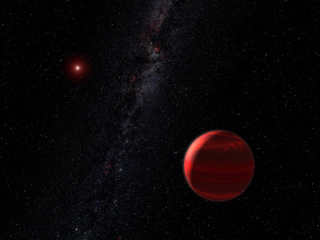
Visible to the naked eye on a clear night sky, stars ranging from first to sixth magnitude are just a fraction of the many dim objects that remain hidden from our view. These objects can only be observed with the aid of astronomical instruments. Among these celestial bodies are red dwarfs, fascinating cosmic luminaries with a magnitude of 11. Despite their prevalence in the Galaxy, red dwarfs remain relatively unexplored. The low luminosity of these stellar pygmies poses a challenge for astronomers studying their properties.
Nonetheless, scientists have possessed basic knowledge concerning red dwarfs for an extended period. Red dwarfs can have a mass that is less than one-tenth of the Sun’s mass. The most substantial example of these diminutive, enduring celestial objects has a weight slightly exceeding fifty percent of Earth’s luminosity. Red dwarfs are characterized by their low temperatures, which span from 2000 K to 3800 K.
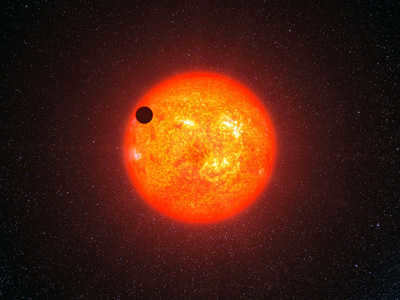
When it comes to the prevalence of red dwarfs, let’s take an intriguing fact into consideration: approximately 80% of the stars in the Milky Way are red dwarfs, totaling around 300 billion stars. In the field of biology, the number of organisms tends to be inversely proportional to their size – the smaller the individual, the greater the population. Stars adhere to the same principle. While in living organisms this phenomenon can be explained by the fact that smaller organisms serve as food for larger ones, resulting in a higher population, in the vastness of space, giant stars cannot consume red dwarfs in any way. So, what’s the reasoning behind this analogy with biological entities?
The inquiry into the extended lifespan of red dwarfs
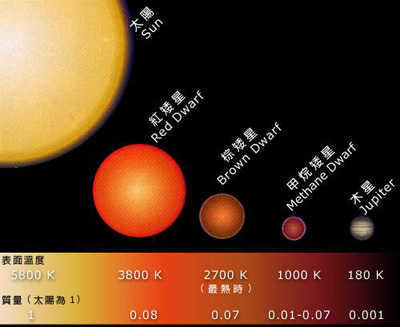
(The image illustrates the various categories of red dwarfs and their respective surface temperatures (K) in comparison to the planet Jupiter)
It is a well-established fact that the larger the mass of a celestial object, the more unstable its condition becomes, resulting in a faster thermonuclear reaction at its core and a higher temperature. The continuous nuclear reactions within red dwarfs commence after billions of years. This phenomenon can be attributed to the weak gravitational force exerted by these low-mass, cold stars. As a result, the evolution of red dwarfs progresses at a significantly slower pace than that of their heavier counterparts. The true age of these small, cold stars is many times greater than that of the massive celestial luminaries.
Astronomers have a strong conviction that as soon as every single generation of brilliant white and yellow stars perishes, scattered throughout the expanse of the Universe, there will persist faint flickers emanating from solitary red dwarfs.
It is possible that this elucidation only partially accounts for the overwhelming abundance of red dwarfs in comparison to other celestial bodies. Astronomers are currently engaged in ongoing investigations in order to further explore this phenomenon.
Stars that emit bursts of light
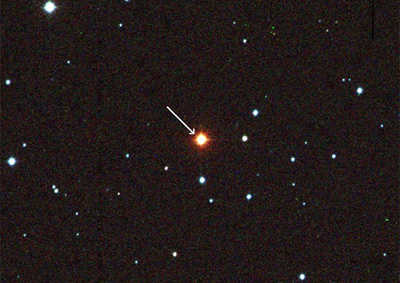
(This photo showcases an erupting UV star of the Keith red dwarf type, specifically the 2MASS J06045215-3433360 star. This star is relatively close to us in astronomical terms.)
Within the realm of dim red dwarfs, there exists a subset known as flaring stars. Due to their extremely low luminosity, only a limited number of these stars have been discovered. Astronomers refer to these flaring red dwarfs as UV Kit stars or variable stars due to their sudden increase in luminosity. The star’s brightness can spike dramatically within a matter of seconds, while the fading process is much slower. Scientists have not yet identified any patterns or periodicity in these flares, as they seem to occur spontaneously. While similar flares can be observed on the Sun, they are significantly weaker in comparison.
Are there planets orbiting red stars?

Astronomers have made a remarkable find – a multitude of planets orbiting red dwarfs. The number of these celestial bodies is considerably less compared to the planets orbiting yellow dwarfs, which are stars resembling our very own Sun. Scientists take this into account when estimating the possibility of life on these planets. However, due to a certain planetary motion pattern within red dwarf systems, the chances of detecting the emergence of biological organisms are quite slim.
It is a fact that life can exist on planets with a short orbital period due to the small mass and low temperature of their star. Only on such close planets can water exist in a liquid state. However, because of the close proximity to the star, the planet will always be facing the star on one side due to the law of gravity. Therefore, the optimal location for potential living organisms is in the twilight zone near the terminator. These conditions are less than ideal for the development of biological species. Nevertheless, scientists do not rule out the possibility of finding life on any planet in a system with a small star, as red dwarfs are prevalent throughout the Universe.
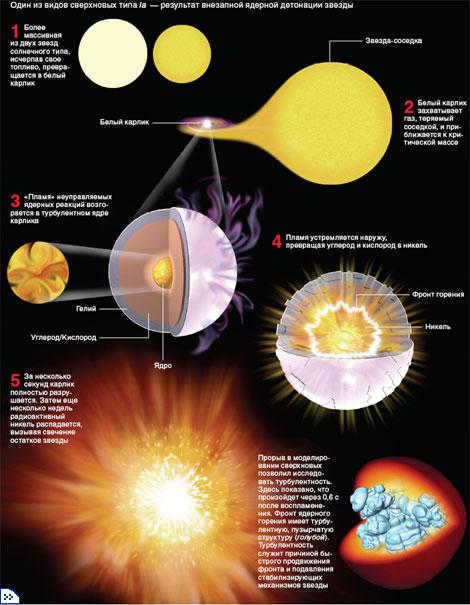
The Universe is filled with a wide variety of stars, each possessing unique qualities and characteristics. From their size and temperature to their charge and composition, stars come in all shapes and forms. In this article, we will delve into the classification of stars, exploring the main types that exist.
One popular method of classifying stars is through spectral classification. This approach categorizes stars based on their unique spectra. By analyzing the observed spectrum, astronomers can gain valuable insights into a star’s surface temperature, luminosity, and even its chemical composition in certain cases. The spectral classification system plays a crucial role in the field of stellar astronomy and astrophysics, aiding in the study and understanding of these celestial objects.
There are certain stars that do not fit into any of the aforementioned spectra. These particular stars are known as pecular stars. They have spectra that cannot be classified within the O-B-A-F-G-K-K-M temperature sequence. While these stars often represent specific evolutionary stages of otherwise normal stars, or stars that are not typical of the Sun’s nearest surroundings (such as metal-poor stars in globular clusters and galactic halos). Notably, stars with pecular spectra encompass stars that possess unique chemical compositions, resulting in the strengthening or weakening of spectral lines for certain elements.
Hertzsprung-Russell diagram
The Hertzsprung-Russell diagram is a graphical representation of the relationship between the luminosity and temperature of stars. It was developed independently by astronomers Ejnar Hertzsprung and Henry Norris Russell in the early 20th century. The diagram is named after these two astronomers who pioneered the field of stellar evolution.
The Hertzsprung-Russell diagram is a useful tool for astronomers to study and classify different types of stars. It plots the absolute magnitude or luminosity of stars against their effective temperature or spectral class. The diagram helps astronomers understand the life cycle of stars and provides insights into their characteristics, such as their size, age, and evolutionary stage.
The main features of the Hertzsprung-Russell diagram include the main sequence, which represents the majority of stars in the universe, and various other regions that correspond to different stages of stellar evolution. These regions include white dwarfs, red giants, and supergiants. Each of these regions represents a different point in the life cycle of a star.
The Hertzsprung-Russell diagram has been instrumental in advancing our understanding of stellar evolution and has allowed astronomers to make significant discoveries about the universe. It continues to be an important tool in modern astronomy and is used by scientists to study and classify stars in various galaxies and star clusters.
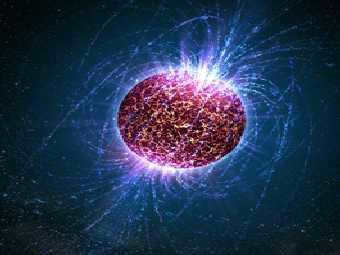
The diagram known as the Hertzsprung-Russell diagram showcases the correlation between a star’s absolute magnitude, luminosity, spectral class, and surface temperature. One intriguing aspect is that the stars on this diagram are not randomly scattered, but rather form distinct regions. This diagram was independently proposed in 1910 by E. Herzsprung and G. Russell and serves as a means to categorize stars in accordance with contemporary understandings of stellar evolution.
The majority of stars can be found on what is known as the main sequence. The reason for the existence of the main sequence is the fact that the stage of hydrogen burning accounts for approximately 90% of the total time of evolution for most stars. As the hydrogen burns out in the central regions of the star, it creates an isothermal helium core, causing the star to transition into the red giant stage and move away from the main sequence. The relatively short lifespan of red giants ultimately leads to the formation of white dwarfs, neutron stars, or black holes depending on their mass.
Yellow dwarf
A yellow dwarf is a type of star that falls within a certain range of mass and temperature. It is commonly referred to as a main sequence star and is located on the Hertzsprung–Russell diagram. Yellow dwarfs are relatively small and dim compared to other types of stars, such as red giants or blue giants. Despite their smaller size, they are still quite hot and can emit a significant amount of light and heat. The Sun is an example of a yellow dwarf star, and it is estimated to be about 4.6 billion years old.
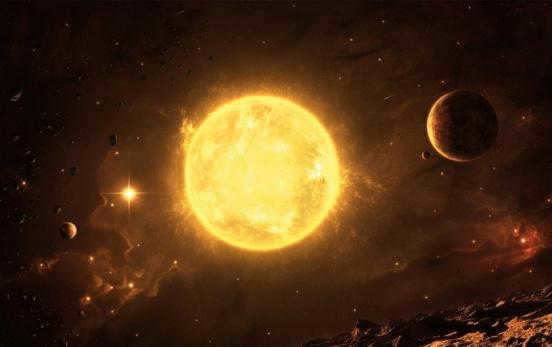
Stars are classified into normal stars, dwarf stars, and giant stars based on their different stages of evolutionary development. Normal stars, also known as yellow dwarfs, are the stars that belong to the main sequence. The Sun, for instance, is an example of a normal star.
During star formation and later stages of development, a star can be referred to as a red giant. In the early phase of evolution, a star emits gravitational energy that is released during compression until the compression is halted by the onset of a thermonuclear reaction. In the later phases of stellar evolution, once hydrogen is depleted in their cores, stars transition away from the main sequence and enter the realm of red giants and supergiants on the Hertzsprung-Russell diagram. This stage accounts for approximately 10% of a star’s “active” lifespan, which encompasses the periods of their evolution when nucleosynthesis reactions occur in the cores of the stars.
Enormous stars
An enormous star has a relatively cool surface temperature of approximately 5000 degrees Celsius. It possesses a massive radius, reaching up to 800 times the size of our sun, resulting in immense luminosity. The majority of its radiation is emitted in the red and infrared regions of the electromagnetic spectrum, which is why they are referred to as red giants.
Dwarf stars are the antithesis of giants and encompass various subcategories:
- White dwarf – Highly evolved stars with masses less than 1.4 solar masses, lacking their own internal sources of nuclear energy. The diameter of these stars can be hundreds of times smaller than that of the sun, resulting in a density that can be 1,000,000 times that of water.
- A red dwarf is a type of small and relatively cool main-sequence star with a spectral class of M or upper K. These stars are quite unique compared to others. Red dwarfs have a diameter and mass that are less than one-third of the sun’s, with the lower mass limit being 0.08 solar mass, followed by brown dwarfs.
- Brown dwarfs are substellar objects with masses ranging from 5 to 75 times that of Jupiter (and a diameter approximately equal to Jupiter’s), but unlike main-sequence stars, they do not undergo thermonuclear fusion reactions to convert hydrogen into helium.
- Sub-brown dwarfs or brown subdwarfs are cold formations that fall below the mass limit of brown dwarfs. They are often considered more similar to planets than stars.
- A black dwarf – White dwarfs that have cooled down and therefore no longer emit visible light. They represent the final stage in the evolution of white dwarfs. The masses of black dwarfs, just like the masses of white dwarfs, are limited to a maximum of 1.4 solar masses.
In addition to these, there are several other outcomes of stellar evolution:
- A neutron star. These are star formations with masses around 1.5 solar masses and noticeably smaller sizes compared to white dwarfs, measuring about 10-20 km in diameter. These stars can have densities as high as 1,000,000,000,000,000,000 times that of water. Additionally, their magnetic fields are many times stronger than Earth’s magnetic field. Neutron stars consist mainly of tightly compressed neutrons due to gravitational forces. Often, these stars are known as pulsars.
- A fresh celestial body. Celestial bodies that experience a sudden surge in brightness, increasing their luminosity by a factor of 10,000. A nova star is a binary system comprising a white dwarf and a companion star on the main sequence. In these systems, gas gradually transfers from the companion star to the white dwarf and periodically erupts there, causing a burst of luminosity.
- A stellar explosion – is a star that concludes its life cycle in a cataclysmic detonation. The burst can be exponentially larger than that of a fresh celestial body. Such an immense explosion is a result of the processes taking place within the star during its final stage of evolution.
- Binary stars consist of two stars that are gravitationally bound and orbit around a common center of mass. Occasionally, there are systems with three or more stars, known as multiple stars. If a stellar system is relatively close to Earth, individual stars can be distinguished through a telescope. However, if the distance is significant, astronomers can only identify double stars based on indirect evidence, such as fluctuations in light caused by one star eclipsing another.
The variety of stars in the Universe is endless, and it is possible that there are still stars or evolutionary products that are not included in this classification. Science is constantly advancing, and there are many more discoveries awaiting us.
Written by: Mikhail Karnevsky and Tatiana Sidorova
Last updated: February 21, 2018
Unauthorized reproduction without a live hyperlink is strictly forbidden!
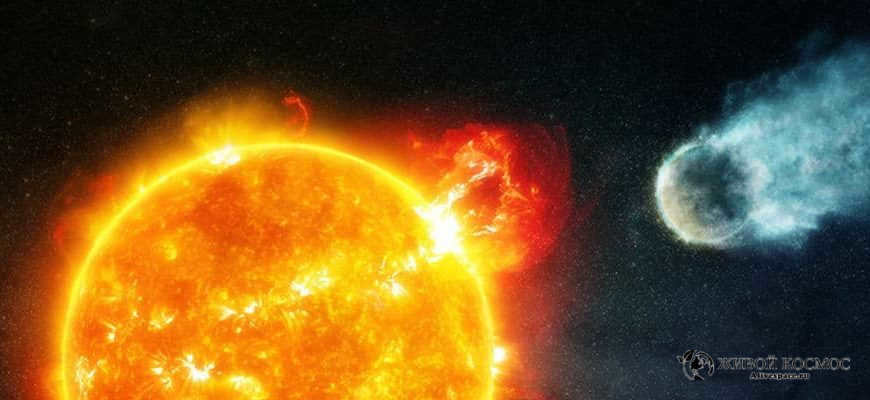
Since the discovery of the first exoplanet, the possibility of life beyond our own planet has captivated the minds of people around the world. The search for a second Earth, a planet with similar conditions to our own, has become a focal point for astronomers and scientists.
Despite extensive research, astronomers have yet to confirm the existence of a planet that is truly Earth-like. However, there are promising candidates, particularly those that orbit red dwarfs, a type of star.
And it’s not a coincidence at all. There are several reasons for this phenomenon. Firstly, red dwarfs are incredibly abundant in space. They are classified as small stars, with a mass that usually ranges between 7 and 60 percent of the Sun’s mass. It is estimated by astronomers that approximately three-quarters of all stars in the universe are red dwarfs! The closest star to our solar system, Proxima Centauri, happens to be a red dwarf. These celestial bodies can be observed in every corner of the cosmos. In fact, the entire universe is teeming with these faint objects, which are often difficult to see or completely invisible due to their low luminosity in our night sky.
Life in the vicinity of red dwarfs
However, this presents a favorable situation for us as it facilitates the discovery of planets in close proximity to red dwarfs. Unfortunately, for these planets, the situation is not as ideal. In order for them to have sufficient light, heat, and favorable conditions for life, they must be positioned very close to their star. This distance is much shorter than the Earth’s distance from the Sun.
Consequently, astronomers have an easier time detecting these planets. This is because the closer a planet is to its star, the more easily it can be found. This is due to the stronger gravitational effect it has on its star. Furthermore, it is more likely to orbit in a way that causes its light to dim. It is these two effects that enable scientists to locate such celestial bodies.
Therefore, numerous exoplanets have already been discovered in close proximity to red dwarf stars, including one in the vicinity of Proxima Centauri.
Consequently, everything appears to be in order. And if the planetary body happens to be similar in size to Earth, it would be incredible!
However, there is a catch: even if this “Earth-like” planet is situated at the optimal distance to maintain potentially habitable temperatures, it does not guarantee habitability. This is due to the complex nature of red dwarf stars!
Tranquil Sun
The Sun in our solar system is classified as a calm star, typically displaying stable behavior. Unlike some of its counterparts, it doesn’t go on a rampage, spewing out massive amounts of matter and emitting intense radiation for no apparent reason. And when we talk about “radiation,” we’re not referring to ordinary light, but rather high-energy X-rays or ultraviolet rays.
Of course, there are occasions when the Sun does experience such events, but they are relatively infrequent. Plus, fortunately for us, the Earth is situated at a safe distance from the Sun, so its impact is minimal.
On the contrary, red dwarfs are much more severe. The intensity and frequency of their outbursts are determined by the internal activities of each individual star. Unlike the Sun, which only experiences convection in its outer layers, red dwarfs exhibit constant circulation throughout their entire structure. This means that hot gas rises from the center and cold gas falls from the top in a perpetual motion. As a result, red dwarfs generate a higher number of stronger flares compared to the Sun.
The Absence of an Atmosphere
Not having an atmosphere would undeniably have a significant impact on the potential atmosphere of the celestial body. If a planet is constantly bombarded by intense radiation emitted by its star, it would ultimately result in the loss of its atmosphere. Atmospheric gases would simply escape into the vastness of space. One can liken this process to that of a sandblaster.
This understandably raises an important question: to what extent would this affect the habitability prospects of a planet situated near a red dwarf?
Fortunately, there is a highly compelling answer to this inquiry, as discovered by Kevin France and his colleagues from the University of Colorado (USA) a few years ago. Their findings were subsequently published in a scientific paper.
Examinations have been conducted on the conduct of Barnard’s star. It is situated merely 6 light years away from us. This red dwarf is the nearest to us subsequent to the three stars of the Alpha Centauri system. Barnard’s star is considerably ancient. It is approximately 10 billion years in age. Consequently, it is nearly twice as old as our sun. This information is significant since it is widely recognized that red dwarfs exhibit particularly high levels of activity during their youth. In fact, they are so active that a planet in close proximity to such a star would likely experience the loss of its atmosphere.
A second attempt?
But what if a red dwarf, in its early stages, is a red dwarf monster, raging and then calming down? Could a new atmosphere be generated on its planets?
Frans and his colleagues examined Barnard’s star using the Hubble Space Telescope. Furthermore, the Chandra space telescope was also employed. The former observed ultraviolet light, while the latter observed X-rays. Both observations took place in 2019. Chandra scrutinized the cosmos on June 17, while Hubble peered into space on March 4.
Throughout the short observation period, both telescopes detected intense bursts of radiation. This indicates that two separate observations carried out at different times exhibited significant stellar activity across various wavelengths.





